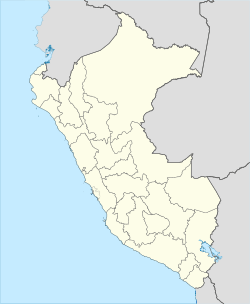Cajatambo facts for kids
Quick facts for kids
Cajatambo
|
|
|---|---|
|
Town
|
|
| Country | |
| Region | Lima |
| Province | Cajatambo |
| District | Cajatambo |
| Elevation | 3,350 m (10,990 ft) |
| Population
(2017)
|
|
| • Total | 2,082 |
| Time zone | UTC-5 (PET) |
Cajatambo (also known as Kashatampu) is a town in Peru. It is the main town, or capital, of the Cajatambo Province in the Lima Region. In 2017, about 2,082 people lived there. The town is located high in the Andes mountains, about 3,350 meters (10,990 feet) above sea level.
Contents
History of Cajatambo
Cajatambo has a long history. It was founded a very long time ago, even before the Spanish arrived in Peru. Back then, it was part of the Inca Empire, which was called Tawantinsuyu.
The town was known as Kasha Tanpu. It was an important stop along the Inca highway, a huge network of roads built by the Incas. Cajatambo was part of a large imperial area called Chinchay Suyu.
People and Languages
In the past, Cajatambo was a much larger town. In 1896, it was thought that around 6,000 people lived there. However, about 15 years later, another count suggested the population was closer to 4,500.
In recent years, many people have moved away from Cajatambo. They often go to bigger cities like Lima to find better jobs and services.
Most people in Cajatambo speak Spanish. About 80% of the population learned Spanish as their first language. Another important language is Quechua, spoken by about 19% of the people. The type of Quechua spoken here is called Cajatambo Quechua. It is a special kind of Quechua I dialect.
What's in a Name?
The name Cajatambo comes from the Quechua language. It combines two words:
- Kasha means "thorn" or "cold."
- Tanpu means "inn" or "resting place."
So, Cajatambo means something like "cold inn" or "thorny resting place."
Geography and Climate
Cajatambo is located in a mountainous area of Peru. It sits in what is known as the Quechua region, which is a high-altitude area. It also borders the Suni region, which is even higher.
The climate in Cajatambo is generally dry and moderately cold. During the day, the sun can feel warm. However, the temperature drops quite a lot at night, making it much colder.
Weather in Cajatambo
| Climate data for Cajatambo (1991–2020) | |||||||||||||
|---|---|---|---|---|---|---|---|---|---|---|---|---|---|
| Month | Jan | Feb | Mar | Apr | May | Jun | Jul | Aug | Sep | Oct | Nov | Dec | Year |
| Mean daily maximum °C (°F) | 15.3 (59.5) |
15.0 (59.0) |
15.1 (59.2) |
16.1 (61.0) |
16.6 (61.9) |
16.6 (61.9) |
16.7 (62.1) |
17.4 (63.3) |
17.5 (63.5) |
16.8 (62.2) |
16.3 (61.3) |
15.4 (59.7) |
16.2 (61.2) |
| Mean daily minimum °C (°F) | 6.1 (43.0) |
6.2 (43.2) |
6.2 (43.2) |
5.8 (42.4) |
5.2 (41.4) |
4.7 (40.5) |
4.3 (39.7) |
4.7 (40.5) |
5.5 (41.9) |
5.8 (42.4) |
5.6 (42.1) |
6.2 (43.2) |
5.5 (41.9) |
| Average precipitation mm (inches) | 103.0 (4.06) |
125.3 (4.93) |
133.2 (5.24) |
52.6 (2.07) |
9.9 (0.39) |
1.4 (0.06) |
0.4 (0.02) |
1.4 (0.06) |
9.7 (0.38) |
33.2 (1.31) |
46.3 (1.82) |
102.5 (4.04) |
618.9 (24.37) |
| Source: NOAA | |||||||||||||
Economy and Products
In the past, silver mining was an important industry near Cajatambo. Many people worked in these mines. However, in 2002, the Peruvian government decided to protect the mountains around Cajatambo. This meant that no more mining was allowed in those areas.
Today, Cajatambo's main industries are farming and raising animals. The town is famous for its delicious local products. These include cheeses, butter, a sweet milk spread called manjar blanco, and crispy fried pork called chicharrón.
Things to See and Do
Cajatambo offers many interesting places for visitors to explore:
- Astobamba's prairie and peaks: These are beautiful open grasslands and tall mountain tops.
- Baths of Shucsha: These are natural hot springs where people can relax.
- Waywash range: This is a stunning mountain range, also known as the Cordillera Huayhuash. It is popular for hiking and climbing.
You can still find old Inca trails around Cajatambo. Local people use these ancient paths for riding horses and donkeys.
The area is also home to many wild animals. You might see Andean foxes, vicuñas (animals related to llamas), vizcachas (which look like rabbits with long tails), and amazing birds like andean condors, eagles, and falcons. Falcons can even be seen flying around the town itself!
See also
 In Spanish: Cajatambo para niños
In Spanish: Cajatambo para niños


